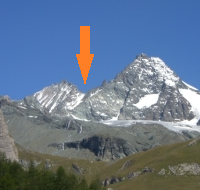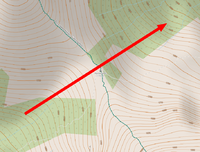Tag:natural=saddle
| Description |
|---|
| The lowest point along a ridge or between two mountain tops |
| Rendering in OSM Carto |
| Group: natural |
| Used on these elements |
| Useful combination |
| See also |
| Status: approved |
| Tools for this tag |
|
A saddle between mountains (topographic saddle) is the area around a saddle point. A saddle point is the lowest point along a ridge or between two mountain tops and the highest point between adjacent valleys or lowlands. The saddle is often a drainage divide between different watersheds.
In general usage another name for saddle is pass or mountain pass (see Wikipedia). However, the term pass is ambiguous. A pass or mountain pass can be a saddle as well as a transport corridor like the Brennerpass between Italy and Austria with roads, railway, tracks and paths.
Unlike in common usage OpenStreetMap clearly differentiates between these two meanings. The notion introduced here is the saddle. For the highway, see mountain_pass=*. Be aware that highways don't always lead exactly through the saddle point, so that the highest point of the highway and the saddle point may have different positions and elevations, especially in low mountain ranges and uplands.
Saddle points are frequently used for defining administrative borders of states, provinces etc.
How to map
A saddle is marked by tagging its saddle point.
- natural=saddle
- name=Älpelesattel
- ele=1772 Elevation of the saddle point; height above sea level in metres.
- direction=NE or direction=45 Cardinal direction of the line connecting the valleys on the sides of the saddle point.
To map the direction, you should draw a line that starts from one of the valley, then goes up to the saddle and finally go down in the second valley. To do this, you need of course to display the elevation lines on the map (like on this map below).
In this example, there is a mountain in the top left corner and another one in the bottom right corner of the image. The valleys are are in the bottom left corner and top-right corner of the image. So the arrow should start in the bottom left corner of the image, then goes up until the saddle and goes down in the valley of the top right corner. So the direction value should be 45 (for 45°) or NE (North-East). Note the direction can also be 225 or SW (South-West) if you choose to draw the line in the opposite direction. This choice is up to you and in really not important. The most important is that the line is correctly placed when choosing the direction.
Rendering example

Depending on the zoom level, OSM Carto renders a symbol ![]() , the name and the elevation, see also natural=peak.
, the name and the elevation, see also natural=peak.
See also
- mountain_pass=*
- Saddle (landform) on Wikipedia

